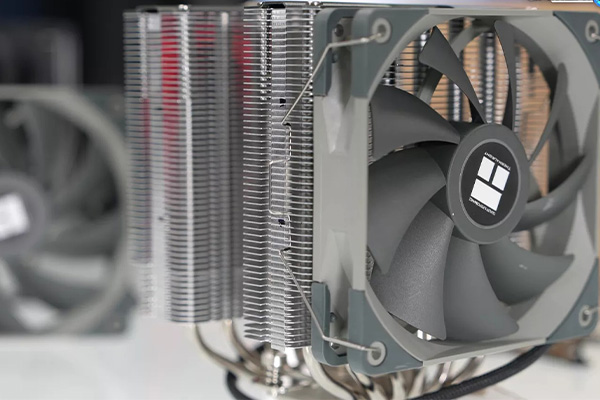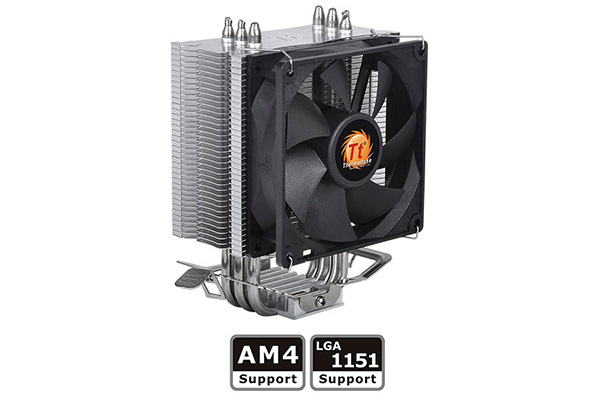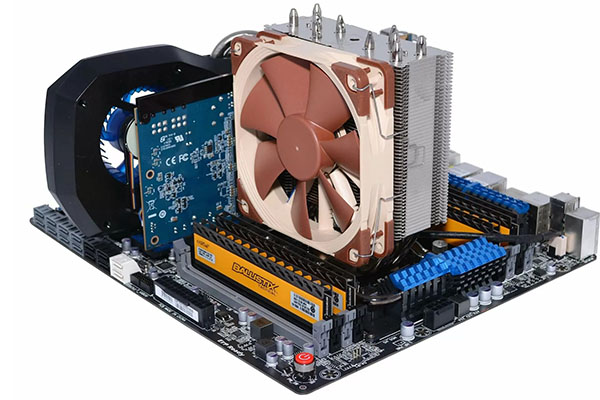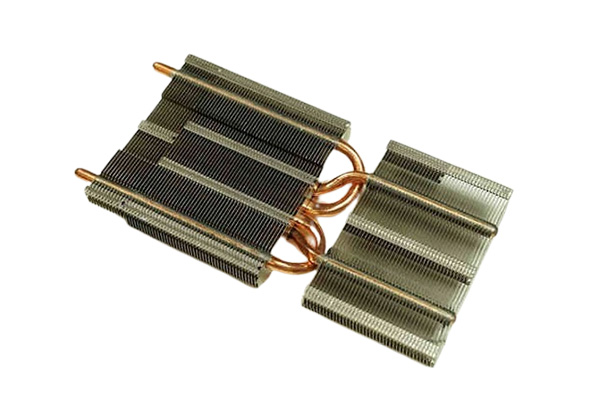Wstęp
Identifying your CPU cooler model might seem like a daunting task, especially if you’re unfamiliar with the internals of your computer. However, it’s an important process that can affect everything from system performance to future upgrades. In this guide, we’ll walk you through the steps of how to easily identify your CPU cooler model. Along the way, we’ll also highlight why knowing your cooler is crucial for making informed decisions about your PC’s performance and maintenance.

1. What is a CPU Cooler?
Let’s start with the basics. What exactly is a CPU cooler? In simple terms, it’s a component designed to prevent your computer’s central processing unit (CPU) from overheating by dissipating the heat produced during its operation. This is essential because high temperatures can cause your computer to slow down or, worse, cause permanent damage.
But here’s the kicker – there are two main types of coolers: air coolers and liquid coolers. Air coolers rely on fans and heat sinks to dissipate heat, while liquid coolers use coolant to transfer heat away from the CPU. While air coolers are generally easier to install and maintain, liquid coolers tend to provide superior performance, especially in high-performance PCs.
Still, regardless of the type of cooler in your system, identifying the model is important. It allows you to know the cooling capacity of your current system, helping you decide whether it’s time to upgrade or perform maintenance.
CPU Cooler Types
| Cooler Type | Pros | Cons |
|---|---|---|
| Air Coolers | Easy to install, less maintenance | Can be bulky, louder at high speeds |
| Liquid Coolers | Better cooling performance, quieter | More complex to install, higher maintenance |
2. Why Do You Need to Know Your CPU Cooler Model?
So, why is it important to identify your CPU cooler model? The answer lies in several key factors: performance, compatibility, and maintenance. If you’re experiencing overheating issues or planning an upgrade, knowing your cooler’s specifications will ensure that you make the right decisions.
What’s the real story here? Without understanding your cooler model, you could end up purchasing a new cooler that isn’t compatible with your system. Or worse, you might neglect the cooler’s maintenance, leading to decreased performance and potential damage to your components. Identifying the model also helps you find compatible replacement parts, such as fans or thermal paste.
Moreover, as your PC ages, your CPU cooler may not be functioning as efficiently as it once did. By identifying the model, you can quickly determine whether it’s time for a replacement.
Common Reasons for Checking Your Cooler
| Powód | Impact |
|---|---|
| Overheating issues | Protects CPU from damage |
| Compatibility with upgrades | Ensures better cooling performance |
| Maintenance and cleaning | Improves longevity and performance |
3. How to Identify Your CPU Cooler Model?
Ready for the good part? Identifying your CPU cooler model doesn’t have to be complicated. There are a few simple methods to get the job done, ranging from manual checks to software tools.
First, let’s talk about manually checking your cooler. This method involves physically opening up your computer case and inspecting the cooler. If you’re comfortable working inside your PC, this is the most direct approach. Most coolers will have a model number stamped or printed on them, so once you locate the cooler, you can check for the label.
Alternatively, you can use software tools like CPU-Z or HWMonitor. These programs give you real-time information about your PC’s components, including the cooler. While they might not display the exact model of your cooler in every case, they will show the temperature and the cooling system being used, which gives you a good indication of what you have.
No matter which method you choose, once you have the model information, you can search for the specifications and determine whether it’s performing optimally or if an upgrade is necessary.
Tools for Identifying Your Cooler
| Method | Pros | Cons |
|---|---|---|
| Manual Check | Direct, no software needed | Requires opening PC case |
| Software Tools (CPU-Z, etc.) | Easy to use, no physical work needed | May not provide exact model info |
4. Where is Your CPU Cooler Located in the Computer?
You might be asking, where exactly is your CPU cooler located? The location of the cooler is relatively straightforward. It is installed on top of the CPU itself. If you open your case, you’ll usually see a large fan and a heat sink mounted directly on the processor. The fan helps push air through the heat sink, aiding in heat dissipation.
Now, let’s talk about what’s inside. Typically, the cooler is held in place with screws or clips. In some systems, you may even find a mounting bracket that secures the cooler to the motherboard. It’s essential to be careful when removing or inspecting the cooler to avoid damaging the delicate components inside your PC.
If you’re unsure of where to start, take a close look at the area around the processor. If you see a fan or a large metal block, you’ve likely found your cooler.
Key Parts of the Cooler
| Part | Function |
|---|---|
| Fan | Moves air through the heat sink |
| Heat Sink | Absorbs and dissipates heat |
| Mounting Bracket/Clips | Secures the cooler to the motherboard |

5. What Tools Do You Need to Check Your CPU Cooler?
What’s the best way to get started? To check your cooler, you don’t need any fancy tools. However, a few basic tools will make the process easier and safer.
At a minimum, you’ll need a screwdriver to open your computer case and possibly unscrew the cooler. It’s a good idea to use a small, magnetic screwdriver to avoid losing screws in your case. Depending on your cooler’s design, you might also need a wrench or specialized tool to remove it.
In addition, some anti-static wristbands are recommended to prevent electrostatic discharge (ESD), which can damage sensitive components inside your PC. If you’re planning to clean or replace your cooler, having some compressed air on hand will also help clear out dust.
Basic Tools for Cooler Check
| Narzędzie | Zamiar |
|---|---|
| Screwdriver | Open the PC case and remove screws |
| Anti-static Wristband | Prevents electrostatic discharge |
| Compressed Air | Cleans dust from the cooler |
6. What Are the Signs That Your CPU Cooler Might Need Replacing?
So, how do you know when it’s time to replace your CPU cooler? There are several telltale signs to look out for. If your PC is running too hot, or if the fan is making unusual noises, these could be indicators that your cooler is malfunctioning. Over time, the thermal paste between the CPU and cooler can dry out, reducing its efficiency.
What’s the kicker here? Regularly monitoring your CPU temperature can give you an early warning of potential issues. If the temperature rises too high, it’s a good idea to check the cooler for dust buildup, faulty fans, or signs of wear. In some cases, replacing the thermal paste can solve the problem and extend the life of your cooler.
Signs of Cooler Malfunction
| Wydanie | Potential Cause |
|---|---|
| Przegrzanie | Dust buildup, worn-out thermal paste |
| Noisy fans | Fan failure, dust buildup |
| Slow PC performance | Inefficient cooling system |
7. How to Measure Your CPU Cooler?
When upgrading your CPU cooler, the first step is measuring the size of your existing cooler. The most common measurements are the fan diameter (usually 120mm or 140mm) and the height of the cooler. These measurements are critical to ensuring that your new cooler will fit inside your PC case.
To get the correct size, use a ruler or measuring tape to check the fan size and height. Most coolers will have this information in the specifications, but it’s always good to double-check before purchasing a replacement.
Measuring Your Cooler
| Measurement Type | Common Sizes |
|---|---|
| Fan Diameter | 120mm, 140mm |
| Cooler Height | Varies, typically 150-170mm |
8. Can You Upgrade Your CPU Cooler?
Here’s the big question – should you upgrade your CPU cooler? The answer depends on your current cooler and how well it’s performing. If you’re running a basic air cooler and your system is showing signs of overheating, upgrading to a liquid cooler could provide better thermal performance.
But wait, there’s more. If you’re planning to overclock your CPU or use your PC for resource-intensive tasks like gaming or video editing, upgrading your cooler might be necessary. Liquid coolers tend to provide superior heat dissipation, especially when pushing your system’s limits.
In many cases, upgrading your CPU cooler is a cost-effective way to prolong the lifespan of your system while improving its performance.
When to Upgrade Your Cooler
| Situation | Recommended Cooler Type |
|---|---|
| Overclocking or high-load use | Liquid Cooler |
| General use, moderate gaming | Air Cooler |
9. How to Clean and Maintain Your CPU Cooler?
Regular cleaning and maintenance are essential for keeping your CPU cooler in good working condition. Over time, dust and debris can accumulate, blocking airflow and reducing the cooler’s efficiency.
Gotowy na najlepszą część? Cleaning your CPU cooler is a simple process that involves removing the cooler, blowing out the dust with compressed air, and wiping it down with a soft cloth. If you’re comfortable with it, you can also replace the thermal paste between the CPU and cooler to restore maximum heat transfer efficiency.
Cleaning and Maintaining Your Cooler
| Krok | Działanie |
|---|---|
| Remove cooler | Carefully detach from the CPU |
| Blow out dust | Use compressed air |
| Clean surface | Wipe with a microfiber cloth |
| Replace thermal paste | Apply new paste for better cooling |

10. How to Install a New CPU Cooler?
If you’ve decided it’s time to replace your CPU cooler, the installation process isn’t too complicated, but it does require some attention to detail. Begin by removing the old cooler and cleaning the surface of the CPU. Apply a small amount of thermal paste to the CPU and then attach the new cooler, making sure it’s securely fastened.
Once installed, reassemble your PC, and test the system. Monitor the temperatures to ensure that the new cooler is performing as expected. Don’t forget to double-check that the cooler is properly aligned and that no cables are obstructing airflow.
Cooler Installation Process
| Krok | Działanie |
|---|---|
| Remove old cooler | Detach and clean the CPU surface |
| Apply thermal paste | Small, even amount in the center |
| Install new cooler | Secure cooler and reassemble PC |
11. What Are the Common Problems with CPU Coolers?
Like any other component, CPU coolers can experience issues over time. Common problems include fan failure, thermal paste degradation, and poor airflow due to dust buildup. If your cooler isn’t working properly, your CPU may overheat, leading to system instability.
What’s the kicker? These problems can often be solved with simple fixes, like cleaning or replacing the thermal paste. However, if your cooler is damaged beyond repair, replacing it entirely may be the best solution.
Common Cooler Problems
| Problem | Rozwiązanie |
|---|---|
| Przegrzanie | Clean cooler, replace thermal paste |
| Noisy fans | Clean or replace fan |
| Inefficient cooling | Upgrade cooler or reapply paste |
12. What Are the Best CPU Coolers on the Market?
Looking for the best CPU cooler? There are a variety of options available, depending on your needs. For high-end performance, liquid coolers like the Corsair H150i are fantastic, providing excellent cooling for overclocked CPUs. If you’re looking for an affordable air cooler, the Noctua NH-D15 is a solid choice, offering impressive cooling without breaking the bank.
Ready for the good part? We’ve broken down some of the top coolers based on performance, price, and ease of use.
Top CPU Coolers
| Cooler Name | Type | Price | Cooling Performance |
|---|---|---|---|
| Corsair H150i | Liquid Cooler | $$$ | Excellent |
| Noctua NH-D15 | Air Cooler | $$ | Very Good |
| Cooler Master Hyper 212 Evo | Air Cooler | $ | Good |
13. How Does a CPU Cooler Affect Your PC’s Noise Level?
It’s not just about cooling; noise is another factor to consider when choosing a CPU cooler. Air coolers tend to be louder, especially at higher fan speeds, while liquid coolers are generally quieter due to their larger, slower-turning fans.
What’s the kicker here? If you’re building a quiet workstation or gaming rig, opting for a quieter liquid cooler could make a big difference.
Noise Levels in Different Coolers
| Cooler Type | Noise Level (dB) |
|---|---|
| Air Cooler | 40–60 |
| Liquid Cooler | 20–30 |
14. What Are the Risks of Using an Incorrect CPU Cooler?
Using an incorrect CPU cooler can have serious consequences. If the cooler is too small or inefficient for your CPU, it can lead to overheating, instability, and permanent damage. In the worst-case scenario, your CPU may fail completely, causing you to lose valuable data or rendering your system inoperable.
Risks of Using the Wrong Cooler
| Ryzyko | Outcome |
|---|---|
| Przegrzanie | CPU damage, system shutdown |
| Poor performance | Reduced system stability |
15. How Often Should You Check and Replace Your CPU Cooler?
How often should you check your CPU cooler? It’s a good idea to inspect your cooler every 6 to 12 months. If you notice any signs of wear, like excessive noise or rising temperatures, it might be time for a replacement.
Recommended Cooler Check Frequency
| Time Interval | Działanie |
|---|---|
| 6 months | Check for dust buildup, clean cooler |
| 12 months | Replace thermal paste, inspect fans |
Wniosek
Identifying your CPU cooler model is crucial for maintaining your PC’s performance. Whether you’re troubleshooting issues or planning an upgrade, knowing which cooler you have ensures you’re making the right decisions. Regular maintenance and occasional upgrades can keep your system running smoothly for years to come.

Często zadawane pytania
Pytanie 1: Czym jest chłodnica procesora?
A CPU cooler is a component designed to dissipate heat from the processor, ensuring that your CPU runs at a safe temperature.
Pytanie 2: How does a CPU cooler work?
A CPU cooler works by transferring heat away from the CPU using either air (via fans) or liquid (via coolant) to maintain optimal performance.
Pytanie 3: How do I know what CPU cooler I have?
You can identify your CPU cooler by manually inspecting your system or using software tools like CPU-Z.
Pytanie 4: Can I use any CPU cooler with my PC?
Not all coolers are compatible with every system. It’s important to check the cooler’s size, mounting system, and thermal performance.
Pytanie 5: How do I clean my CPU cooler?
To clean your cooler, remove it, use compressed air to blow out dust, and wipe it down with a microfiber cloth.

